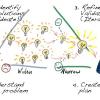|
|
A Practical Framework for Software Measurement Measurement is often defined in terms of collecting data, distinguishing it from analysis-the interpretation and use of data. Clearly, the collection of data must be driven by its intended use. In this presentation, David Card presents a framework that treats measurement and analysis as an integrated process. Discover the four basic components of this framework, and learn how to use the framework to ensure that all-important perspectives and potential users of measurement are considered in the measurement planning process.
|
David Card, Software Productivity Consortium
|
|
|
Predictive Metrics to Estimate Post Project Costs How much will it cost to support your software project based on current estimations? Discover the answer to this question by using statistical estimation methods-including the S-curve and the Rayleigh curve-to help you determine where your projects are in relation to required quality and trendings to meet your post-project cost goals. Learn how to use metrics to predict post-project costs and make better release decisions based on these predictions.
|
Geoffrey Facer, Intel Corporation
|
|
|
Experiences with Global Software Architecture Design and Development In this paper, we describe our experience designing and developing a system-for acquiring and processing data from electric, gas, and water meters-among four development sites located in Switzerland, Germany, and the U.S. Some of the techniques we used for project planning and management are described. We observed that a number of multicultural variables affect the overall performance of the development team. Based on our experience, a set of recommendations is given for managing global software development teams. Although we collectively felt that a single-site project team is likely to be more efficient than a multi-site team, the diversity of ideas and skills offered by a multi-site team resulted in a product line architecture that is flexible, modifiable, and adaptable to different market requirements.
|
Daniel Paulish, Siemens Corporate Research
|
 |
Design Thinking: 4 Steps to Better Software Design thinking points out several missed steps in software development. And, while some may believe ideation and iteration to be wasteful, they're easy to add to the development process at low cost and, in the end, result in substantially more valuable software. In this article, Jeff Patton describes the four basic steps of design thinking.
|
|
|
|
Software Development Lifecycle: Defect and Test Case Measurement This article focuses on how to manage the defect and test case measurement during the software development lifecycle. This should be a practical resource for software developers and project managers.
|
|

